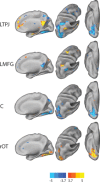Spatial and temporal functional connectivity changes between resting and attentive states
- PMID: 25271132
- PMCID: PMC6869123
- DOI: 10.1002/hbm.22646
Spatial and temporal functional connectivity changes between resting and attentive states
Abstract
Remote brain regions show correlated spontaneous activity at rest within well described intrinsic connectivity networks (ICNs). Meta-analytic coactivation studies have uncovered networks similar to resting ICNs, suggesting that in task states connectivity modulations may occur principally within ICNs. However, it has also been suggested that specific "hub" regions dynamically link networks under different task conditions. Here, we used functional magnetic resonance imaging at rest and a continuous visual attention task in 16 participants to investigate whether a shift from rest to attention was reflected by within-network connectivity modulation, or changes in network topography. Our analyses revealed evidence for both modulation of connectivity within the default-mode (DMN) and dorsal attention networks (DAN) between conditions, and identified a set of regions including the temporoparietal junction (TPJ) and posterior middle frontal gyrus (MFG) that switched between the DMN and DAN depending on the task. We further investigated the temporal nonstationarity of flexible (TPJ and MFG) regions during both attention and rest. This showed that moment-to-moment differences in connectivity at rest mirrored the variation in connectivity between tasks. Task-dependent changes in functional connectivity of flexible regions may, therefore, be understood as shifts in the proportion of time specific connections are engaged, rather than a switch between networks per se. This ability of specific regions to dynamically link ICNs under different task conditions may play an important role in behavioral flexibility.
Keywords: attention; connectivity; hubs; networks; resting functional magnetic resonance imaging.
© 2014 Wiley Periodicals, Inc.
Figures







References
-
- Arnold AE, Protzner AB, Bray S, Levy RM, Iaria G (2014): Neural network configuration and efficiency underlies individual differences in spatial orientation ability. J Cogn Neurosci 26:380–394. - PubMed
Publication types
MeSH terms
LinkOut - more resources
Full Text Sources
Other Literature Sources
Miscellaneous

